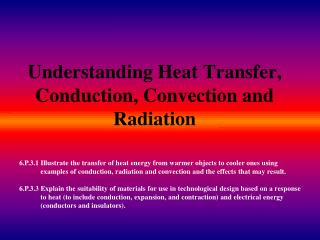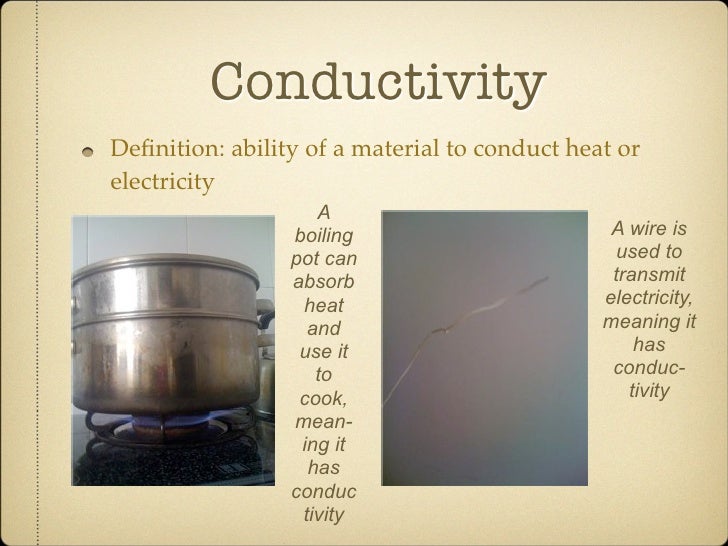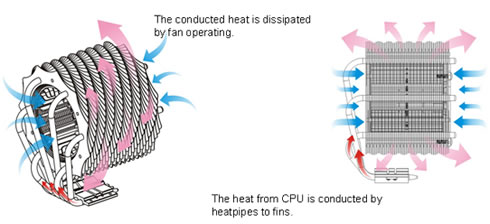Heat Conduction
Data: 3.09.2017 / Rating: 4.7 / Views: 990Gallery of Video:
Gallery of Images:
Heat Conduction
Heat can only be transferred through three means: conduction, convection and radiation. Of these, conduction is perhaps the most common, and occurs regularly in nature. In short, it is the transfer of heat through physical contact. Nov 19, 2010A Rap of Conduction, Convection, and Radiation done for a school project Sources: Idea Song from: conduction heat energy until you understand Jun 13, 2012Thermal Conductivity, Stefan Boltzmann Law, Heat Transfer, Conduction, Convecton, Radiation, Physics Duration: 29: 23. The Organic Chemistry Tutor 20, 681. Radiation is a method of heat transfer that does not rely upon any contact between the heat source and the heated object as is the case with conduction and convection. Heat can be transmitted through. Define conduction: the act of conducting or conveying conduction in a sentence Can you improve the answer. Heat transfer by conduction can be used to model heat loss through a wall. For a barrier of constant thickness, the rate of heat loss is given by: Enter data below. Heat transferthe physical act of thermal energy being exchanged between two systems by dissipating heatcan be grouped into three broad categories: conduction. The transference or dispersion of heat can occur by means of three possible mechanisms, conduction, convection and radiation. Convective heat transfer Heat conduction (or thermal conduction) is the movement of heat from one solid to another one that has different temperature when they are touching each other. For example, we can warm our hands by touching hotwater bottles. Thermal conductivity Heat Transfer: Conduction I Page 1 of 4 Heat Transfer: Conduction I We will now enter a new area, heat conduction. This is not really a move away from energy Conduction A Particle View. Let's begin our discussion by returning to our thought experiment in which a metal can containing hot water was placed within a. Heat can only be transferred through three means: conduction, convection and radiation. Of these, conduction is perhaps the most common, and occurs regularly in nature. In short, it is the transfer of heat through physical contact. Heat transfer is the exchange of thermal energy between physical systems. The rate of heat transfer is dependent on the temperatures of the systems and the properties of the intervening medium through which the heat is transferred. Convection Heat can be transferred from place to place by conduction [conduction: The transfer of heat energy through a material without the material itself moving. , convection [convection: The transfer of heat. Heat transfer Need help with your Science homework? In this animated activity, learners explore three major methods of heat transfer and practice identifying each. How can the answer be improved. Heat equation Start studying Examples of Conduction, Convection, and Radiation. Learn vocabulary, terms, and more with flashcards, games, and other study tools. Heat Transfer Note: Energy is the conserved quantity Conduction: Heat transfer due to molecular activity. Energy is transferred from more energetic to less. Heat conduction, or thermal conduction, is the spontaneous transfer of thermal energy through matter, from a region at higher temperature to a region at lower temperature. It thus acts to equalize temperature differences. It is also described as heat energy transferred from one material to. Thermal conduction is the transfer of heat (internal energy) by microscopic collisions of particles and movement of electrons within a body. The microscopically colliding objects, that include molecules, atoms, and electrons, transfer disorganized microscopic kinetic and. Thermal conduction, transfer of energy (heat) arising from temperature differences between adjacent parts of a body. Thermal conductivity is attributed to the exchange of energy between adjacent molecules and electrons in the conducting medium.
Related Images:
- Voda v pryhorshchi pdf
- Soluciones Practicas Practical Solutions Spanish
- Shorter Walks in the Dolomitespdf
- Arturo frondizi
- Marine Corps Land Navigation Manuals
- Enw9504 Driverzip
- Pengertian politik menurut para ahli luar negeri
- Remo Repair PSD
- 1994yamahawaverunneriiigp
- Ps3lastofusinstruction
- Miss Malarkey Leaves No Reader Behind Lesson Plans
- James e la pesca gigantepdf
- Windows 10 repair
- Sony StrDh550 Manual
- Serial pdffactory pro 47
- Test Germana Clasa 0
- Bosch kts 570 update
- Il soffio dellorsapdf
- Canon drivers and Software Printer Mp258 Fullzip
- ApWorldHistoryChapter31Test
- Xtrememac Luna Voyager User Manualpdf
- Ct2 finance and financial reporting notes
- WhatAreThreeExamplesOfProducers
- Samsung P3100 Auto Charging Solution
- Kyocera Taskalfa 6500i 8000i Service Manual
- Maytag Neptune Manual Door Release
- The Encyclopedia Of Taekwon Do Patterns Vol 1
- Download Dx9reg
- Chicano Studies Survey and Analysis
- Materi jaringan tumbuhan dan hewan
- Dell Battery drivers Windows 8 64 bitzip
- Ghid De Nursing Vol 2 Pdf
- Vaillant vrt 330 user manual
- Kanmani en kanmani son
- Craftsman easyfire staple gun manual 68492
- Listening Closely A Journey To Bilateral Hearing
- Vectric Cut2d
- Philosophy of Physics Space and Time
- Exalted black and white treatise pdf
- Citta in neropdf
- Malala
- Disidente discografia completa descargar antivirus
- Maa par rakhna vishwasmp3
- Les Tresors Des Princes De Bourbon Conti
- Como crear objetos 3d con blender
- Audio Driver SiS 962lzip
- Databasemanagementsystemssolutionsmanual
- El jefe iba descalzo marcio veloz maggiolo descargar
- Teaching Commas In A Series
- Huawei Mobile No Driver Foundzip
- Manual De Cocina Indurama Florencia
- Tomi Ungerer A Treasury of 8 Books
- Big Ideas Math Grade 6 Answer Key
- Cognitive psychology galotti pdf
- El Adulterio Pdf Gratis
- Caminante Esta Loco
- NetSupport Manager Control Client
- First Course In Probability 9e Solutions Manual
- Citizen Rechargeable Battery For Caliber H145
- Bsc 3rd Year Physics Question Papers
- BumsBesuch 17 09 21 Jezzicat XXX
- Lettere a un aspirante romanzieremobi
- Ducotedechezswann
- Libros acerca del feudalismo
- Auggie Me Three Wonder Stories
- Gburner crack keygen serial patch
- All Things Algebra 2 Step Maze
- Pengaruh penggunaan media pembelajaran
- Dimmi che ti dispiaceepub
- Libros De Cultura Organizacional De Edgar Schein
- Le Ciel A Loeil Nu En
- Palfinger Pk23002 Parts Manual
- Descargar Sudokus Pdf
- Glossary Literary Terms M H Abrams
- Google web designer tutorial for beginners pdf
- 2009 Honda Civic Manuals Transmission
- European Revolutions 14921992 Making of Europe











